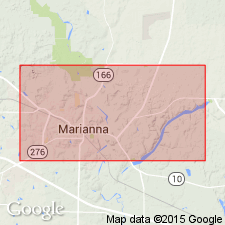
- Usage in publication:
-
- Mariana building stone
- Modifications:
-
- Original reference
Summary:
Pg. 128-132. Mariana building stone is an orbitoidal limestone of Vicksburg type [but he included it in Miocene.]
[Named from exposures at Marianna, Jackson Co., FL, east edge of twon, where the rock is quarried.]
Source: US geologic names lexicon (USGS Bull. 896, p. 1298).
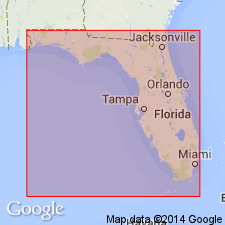
- Usage in publication:
-
- Marianna limestone*
- Modifications:
-
- Areal extent
- Dominant lithology:
-
- Limestone
- AAPG geologic province:
-
- Mid-Gulf Coast basin
Summary:
Table opp. p. 50 and p. 51-59. Marianna limestone. Soft porous light-gray to white marine limestones, containing some marl and more rarely clay beds; layers of chert are common. Characterized by abundance of ORBITOIDES MANTELLI and other Foraminifera associated with many other fossils; PECTEN POULSONI and P. PERPLANUS common. [P. PERPLANUS does not occur in Marianna limestone as now defined, but is characteristic of Ocala limestone, according to C.W. Cooke.] Lithologically resembles Ocala limestone at Ocala, but differs from it in character of its fauna. Also closely resembles "Peninsular" limestone. Thickness approximately 220 feet. It is believed to underlie Ocala limestone. In western Florida is unconformably overlain by beds belonging to Apalachicola group or by post-Pliocene formations. [Age is early Oligocene.]
Source: US geologic names lexicon (USGS Bull. 896, p. 1298).
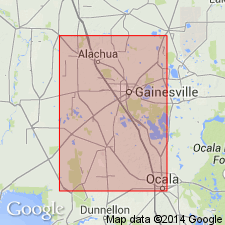
- Usage in publication:
-
- Marianna limestone*
- Modifications:
-
- Overview
- AAPG geologic province:
-
- Mid-Gulf Coast basin
Summary:
Marianna limestone of Vicksburg group. Work by C.W. Cooke (USGS Prof. Paper 95, p. 109, 1915) resulted in showing that Marianna limestone overlies Ocala limestone, and (Washington Acad. Sci. Jour., v. 8, p. 187, 195, 1918) in introducing Glendon limestone for upper member of the Marianna. In 1923 (USGS Prof. Paper 133) Cooke elevated Glendon to rank of a formation and restricted Marianna limestone to the "chimney rock." He later found that in part of western Alabama and Mississippi the Marianna overlies Red Bluff clay, which is stratigraphically equivalent of lower part of the Marianna to east. As now defined the Marianna limestone is the white limestone or "chimney rock" that overlies Ocala limestone at Marianna and carries LEPIDOCYCLINA MANTELLI and PECTEN POULSONI. (C.W. Cooke and S. Mossom, 1929, Florida Geol. Survey 20th Ann. Rpt., 1929.) Age is early Oligocene.
Source: US geologic names lexicon (USGS Bull. 896, p. 1298).
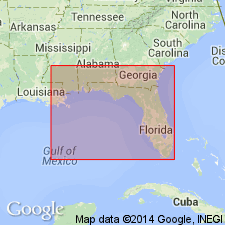
- Usage in publication:
-
- Marianna limestone
- Modifications:
-
- Revised
- AAPG geologic province:
-
- Mid-Gulf Coast basin
Summary:
Pg. 1315 (fig. 1), 1324, 1329. Marianna limestone of Vicksburg group. Sediments included in formation consist of soft chalky limestone, locally called chimney rock; some local, hard limestone; tough to hard ledges in the chimney rock; sandy glauconitic limestone; marl; calcareous sand; lignitic clay. Thickness probably not more than 60 feet. In Mississippi and western Alabama, includes limestone; in Mississippi and Alabama, Forest Hill sand and Red Bluff clay. Underlies Byram formation (Glendon limestone member). [Age is middle Oligocene.]
Source: US geologic names lexicon (USGS Bull. 896, p. 1298).
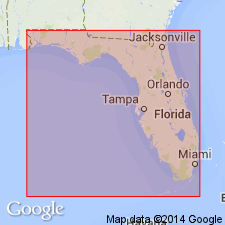
- Usage in publication:
-
- Marianna limestone*
- Modifications:
-
- Age modified
- AAPG geologic province:
-
- Mid-Gulf Coast basin
Cooke, C.W., 1945, Geology of Florida: Florida Geological Survey Bulletin, no. 29, 339 p.
Summary:
Pg. 75-81. Marianna limestone of Vicksburg group. In Mississippi and western Alabama, the Marianna is separated from Eocene formations by lower Oligocene Red Bluff clay, but, in Florida it lies directly on Ocala limestone. Seems probable that Marianna overlaps lower Oligocene deposits somewhere in Alabama and lies unconformably on Ocala in Florida. Underlies Byram limestone. Thickness about 30 feet at Marianna; as much as 80 feet in western Alabama. Not recognized east of Chattahoochee and Apalachicola Rivers, either in Georgia or Florida. Age is middle Oligocene.
Source: US geologic names lexicon (USGS Bull. 1200, p. 2378).
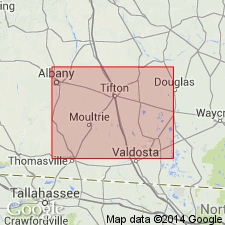
- Usage in publication:
-
- Marianna Limestone*
- Modifications:
-
- Areal extent
- AAPG geologic province:
-
- South GA-North FL sedimentary province
Summary:
Marianna Limestone extended into subsurface of southwestern Georgia. Age is middle Oligocene.
Source: Modified from GNU records (USGS DDS-6; Reston GNULEX).
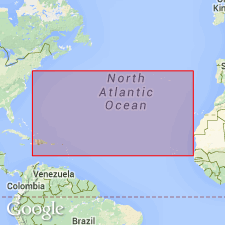
- Usage in publication:
-
- Marianna Limestone*
- Modifications:
-
- Age modified
- AAPG geologic province:
-
- Mid-Gulf Coast basin
Summary:
Age of Vicksburg Group, to which Marianna Limestone is assigned, is changed from middle Oligocene to early Oligocene.
Source: GNU records (USGS DDS-6; Reston GNULEX).
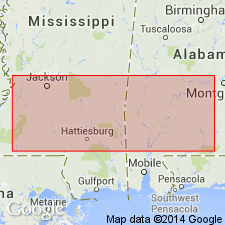
- Usage in publication:
-
- Marianna Formation*
- Modifications:
-
- Revised
- AAPG geologic province:
-
- Mid-Gulf Coast basin
Summary:
Marianna Formation. Mint Spring Marl Member removed from base of Marianna and raised in rank to Mint Spring Formation of Vicksburg Group. Name changed from Marianna Limestone to Marianna Formation. Assigned to Vicksburg Group in Alabama and Mississippi [not assigned to the Vicksburg in Florida and Georgia]. Underlies Glendon Formation of Vicksburg Group.
Source: Modified from GNU records (USGS DDS-6; Reston GNULEX).
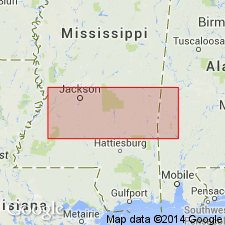
- Usage in publication:
-
- Marianna Limestone
- Modifications:
-
- Biostratigraphic dating
- AAPG geologic province:
-
- Mid-Gulf Coast basin
Summary:
Calcareous nannoplankton floras from the Mint Spring Formation and the Marianna Limestone indicate that these formations are diachronous along their outcrop belt in Mississippi and southwest Alabama. In east-central Mississippi and Alabama, these strata correlate to the ERICSONIA SUBDISTICHA zone (NP21), while in west-central Mississippi, they contain nannofossils of the younger HELICOSPHAERA RETICULATA zone (NP22).
Source: GNU records (USGS DDS-6; Reston GNULEX).
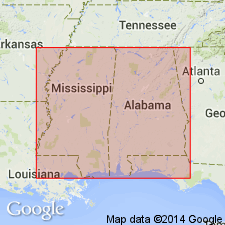
- Usage in publication:
-
- Marianna Limestone
- Modifications:
-
- Overview
- AAPG geologic province:
-
- Mid-Gulf Coast basin
Summary:
In AL, the stratigraphic interval that includes the Marianna was originally referred to as the "St. Stephens White Limestone by Smith and Johnson (1887) and by Smith and others (1894). The middle member of the St. Stephens is equivalent to the Marianna limestone of Cooke (1918). At St. Stephens Quarry, the Marianna consists of approximately 60 ft of soft white to gray fossiliferous limestone, which is slightly glauconitic and argillaceous in the lower part. From St. Stephens westward into MS, the Mint Spring Marl (Member/Formation) is recognized at the base of the Marianna. At St. Stephens, the Mint Spring Marl Member consists of approximately 1.5 ft of yellowish-gray argillaceous, silty, glauconitic, pyritic, fossiliferous marl. The upper limestone facies of the Marianna thins and becomes more sandy and glauconitic into MS and the Mint Spring Formation, as it is called in MS, thickens. Along the Chickasawhay River, Wayne Co., MS, the Marianna consists of approximately 40 ft of light-gray to yellowish-gray argillaceous, fossiliferous limestone. In this area, the Mint Spring, which ranges in thickness from approximately 1 ft to as much as 17 ft, consists primarily of dark-gray argillaceous to arenaceous, fossiliferous, glauconitic marl. In Smith Co., MS, the Marianna does not exceed 12 ft in thickness and the lower 6 ft is very sandy. The Mint Spring in this area averages 12 ft in thickness and consists of greenish-gray fossiliferous, glauconitic, pyritic, sandy marl and greenish-gray medium- to coarse-grained, glauconitic, fossiliferous sand. On Mint Spring Bayou near Vicksburg, Warren Co., MS, the most western reported occurrence of the limestone facies, the Marianna consists of only 3 ft of sandy, fossiliferous limestone, while the Mint Spring consists of 25 ft of glauconitic fossiliferous sand and marl that disconformably overlies the Forest Hill Sand.
Source: GNU records (USGS DDS-6; Reston GNULEX).
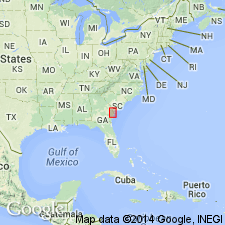
- Usage in publication:
-
- Marianna Limestone
- Modifications:
-
- Areal extent
- AAPG geologic province:
-
- South Georgia sedimentary province
Summary:
Use of the Vicksburg Group is extended to GA in that outliers of the Marianna and Glendon Limestones are present. In GA, the only known occurrence of Marianna Limestone is in a small area in and immediately south of Hawkinsville in Pulaski Co. It is well exposed along the Ocmulgee River on the south side of Hawkinsville and in river bluffs 1.2 mi south of Hawkinsville. In the Chattahoochee Embayment in southwestern GA, the Marianna of Sever and Herrick (1967) and the Marianna Limestone equivalent of Zimmerman (1977) are the Ochlockonee Formation of this report. The Marianna in Pulaski Co., GA, is lithologically typical for the formation and is essentially the "chimney rock" of the type area. Unit is finely granular with substantial interstitial "limepaste" or micrite and is chalky in appearance. A few fossils supply the only coarse, bioclastic material. The limestone is unconsolidated and soft, but coherent. For the most part, it is massive and thick-bedded. Type section of the Marianna in FL is clearly identified in this report. Paraconformably overlies the Ocmulgee Formation in Pulaski Co. and conformably underlies the Glendon Limestone or disconformably underlies the Hawthorne Group. Age of the Marianna is early Oligocene (Rupelian), middle Vicksburgian.
Source: GNU records (USGS DDS-6; Reston GNULEX).
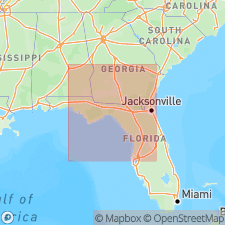
- Usage in publication:
-
- Marianna Limestone
- Modifications:
-
- Geochronologic dating
- AAPG geologic province:
-
- Florida platform
Summary:
Authors use 87Sr/86Sr isotopic analyses in an attempt to resolve age relations of fossiliferous marine units that contain the remains of terrestrial vertebrates. Samples from the Marianna Limestone produce an early Oligocene age of 33.4 Ma, slightly younger than the 34.8 Ma Suwannee Limestone. The next youngest unit, the Tampa Member of the Arcadia Formation, yielded a late Oligocene age of 25.4 Ma.
Source: GNU records (USGS DDS-6; Reston GNULEX).
For more information, please contact Nancy Stamm, Geologic Names Committee Secretary.
Asterisk (*) indicates published by U.S. Geological Survey authors.
"No current usage" (†) implies that a name has been abandoned or has fallen into disuse. Former usage and, if known, replacement name given in parentheses ( ).
Slash (/) indicates name conflicts with nomenclatural guidelines (CSN, 1933; ACSN, 1961, 1970; NACSN, 1983, 2005, 2021). May be explained within brackets ([ ]).

